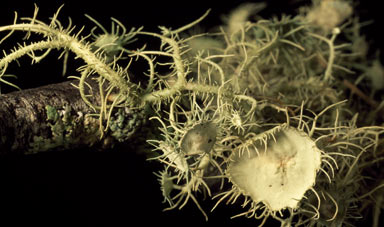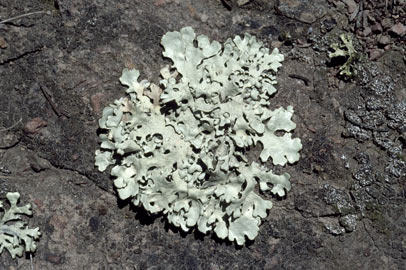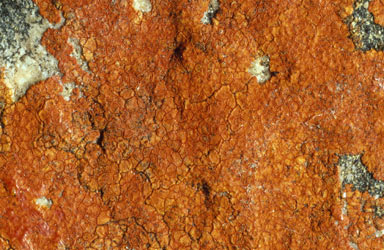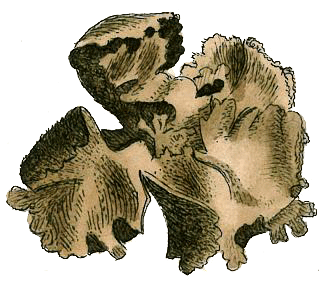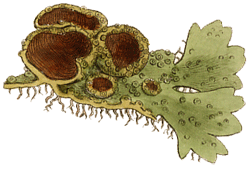
What is a lichen?
If you read no more than this page, you will gain a good basic understanding of lichens. Much of the rest of the website consists of expansions of the topics presented here and you can get to many of those expansions by clicking on the embedded links.
A lichen is not a single organism. Rather, it is a symbiosis between different organisms - a fungus and an alga or cyanobacterium. Cyanobacteria are sometimes still referred to as 'blue-green algae', though they are quite distinct from the algae. The non-fungal partner contains chlorophyll and is called the photobiont. The fungal partner may be referred to as the mycobiont. While most lichen partnerships consist of one mycobiont and one photobiont, that's not universal for there are lichens with more than one photobiont partner. When looked at microscopically, the fungal partner is seen to be composed of filamentous cells and each such filament is called a hypha. These hyphae grow by extension and may branch but keep a constant diameter. Amongst the photobionts there are those that are also filamentous in structure while others are composed of chains or clusters of more-or-less globose cells.
Given that they contain chlorophyll, algae and cyanobacteria can manufacture carbohydrates with the help of light via the process of photosynthesis. By contrast, fungi do not make their own carbohydrates. Every fungus needs existing organic matter from which to obtain carbon. In a lichen some of the carbohydrate produced by the photobiont is of course used by the photobiont but some is 'harvested' by the mycobiont.
Worldwide, over 20,000 species are known and over 3,000 are known from Australia. There has been scientific study of Australian lichens over the past two centuries, though with somewhat erratic progress during the first century and a half since European settlement. You can find out more via the HISTORY OF AUSTRALIAN LICHENOLOGY page.
Lichens can be found growing in almost all parts of the terrestrial world, from the ice-free polar areas to the tropics, from tropical rainforests to those desert areas free of mobile sand dunes. While generally terrestrial a few aquatic lichens are known. The surfaces (or substrates) on which lichens grow vary from the natural (such as soil, rock, wood, bone) to the man-made (bitumen, concrete, glass, canvas, metal - to give just a few examples).
Lichens possess structures not formed by either of the partners and produce chemicals usually absent when the fungus or the photobiont are cultivated separately and so lichens are more than a sum of their parts. In fact, lichens synthesize over 800 substances, many of them not found elsewhere in nature. Though the fungi that form lichens do not occur in nature as independent organisms, a number of the photobionts can be found in free-living forms. It is possible to separately culture the two partners in the laboratory but it is difficult to resynthesize the lichen. Success has been achieved when the fungus and photobiont are placed under stress (e.g. by reducing water and nutrient levels), suggesting that originally lichen partnerships formed to overcome adversity.
As well as having important ecological roles lichens have also been used by humans as food, medicine and for the dyeing of cloth. For example, traditionally lichens were used to produce the colours of Harris tweed. There's more about the subject on the LICHENS AND PEOPLE page.
Classification and identification
Lichens are classified with the fungi (being sometimes referred to as lichenized fungi). The fungi incorporated into lichens are largely ascomycetes, with very few basidiomycetes involved. If you are not familiar with the terms ascomycete or basidiomycete you will find brief explanations in the FUNGAL BASICS CASE STUDY. Though a number of lichen species can be readily identified in the field the precise identification of many lichens demands examination of their macroscopic and microscopic structures (such as reproductive structures, spores and cellular features) as well as chemical tests. Chemical reagents can be applied to the lichen tissues and the presence or absence of a colour change noted but such ‘spot’ tests are crude and chromatographic methods yield more precise analyses. The usefulness of the chemical tests lies in the fact that the chemical substances are often species specific.
There's more about these subjects on the CLASSIFICATION and the LICHEN CHEMISTRY pages.
Growth forms
Lichens show a variety of growth forms and there are terms used to name these forms. The following are three very commonly seen types:
Those three growth forms will account for the majority of genera that most people are likely to see. It is also worth mentioning the concept of a squamulose lichen since the genus Cladonia ![]() is very widespread and often shows a squamulose growth form. But the species in the genus also produce upright fruticose structures called podetia - sometimes with the appearance of fairly simple stalks, sometimes flared at the apex and so presenting a somewhat trumpet-like form.
is very widespread and often shows a squamulose growth form. But the species in the genus also produce upright fruticose structures called podetia - sometimes with the appearance of fairly simple stalks, sometimes flared at the apex and so presenting a somewhat trumpet-like form.
In this photo ![]() you can see a Cladonia colony growing on soil. There are numerous squamules on the soil but you can also see a number of the upright podetia with broader apices. Moreover, at the margins of some of the broader apices you can see additional podetia developing. Here
you can see a Cladonia colony growing on soil. There are numerous squamules on the soil but you can also see a number of the upright podetia with broader apices. Moreover, at the margins of some of the broader apices you can see additional podetia developing. Here ![]() is a closer view, showing an enlargement of part of the previous photo. You can also see that the podetia themselves also have flake-like squamules. Cladonia is not the only squamulose lichen genus, just a very commonly seen one. A colony of a squamulose lichen looks like a scattering of small flakes or scales on the substrate. A byssoid lichen
is a closer view, showing an enlargement of part of the previous photo. You can also see that the podetia themselves also have flake-like squamules. Cladonia is not the only squamulose lichen genus, just a very commonly seen one. A colony of a squamulose lichen looks like a scattering of small flakes or scales on the substrate. A byssoid lichen ![]() has a somewhat wispy appearance, like cotton-wool teased out to some degree. Leprose lichens
has a somewhat wispy appearance, like cotton-wool teased out to some degree. Leprose lichens ![]() have a powdery or granular appearance. You can find combinations of growth forms in some lichens. For example, some species are crustose centrally but somewhat foliose at the margins. Just in case you're interested, such a lichen is called placodioid or placoid and Placopsis perrugosa
have a powdery or granular appearance. You can find combinations of growth forms in some lichens. For example, some species are crustose centrally but somewhat foliose at the margins. Just in case you're interested, such a lichen is called placodioid or placoid and Placopsis perrugosa ![]() is an example.
is an example.
|
All of these expressions may be called usefully imprecise descriptive terms. They are useful in the same way that expressions such as shrub and tree are useful when talking about plants. They are imprecise in that sometimes it may be difficult to place a particular specimen in a particular growth form 'pigeon-hole'. Similarly, occasionally you may wonder which of shrub or tree is the better term to describe a particular plant. What of the byssoid lichens? Logically you could argue that a byssoid growth form is three dimensional (as is a clump of cotton wool) and so a byssoid lichen is really just a very delicate fruticose lichen. Some lichenologists consider squamulose and placodioid forms as simply variants of crustose. As you can see there is a variety of terms (more than listed above) and some debate over the boundaries between them. It is useful to be aware of these issues, since different books or websites may use some terms in slightly different senses, but there is no point in getting bogged down in terminology. For most purposes it is enough to be comfortable with the terms crustose, foliose, fruticose and squamulose as defined above.
In general a particular species will show the same growth form, no matter where it grows. Occasionally, for some reason (perhaps genetic, perhaps environmental), a species that is usually, say, crustose might grow in a fruticose form. Such occasional, but dramatic, differences in growth form in the one species are well-known to many gardeners. A plant species that usually grows as a tree may be found growing in, say, a prostrate form. Often such plant variants are highly valued horticulturally and propagated vegetatively to preserve the variant form and sold as cultivars of the species in question.
You may come across the terms macro-lichen and micro-lichen. These are two more examples of usefully imprecise terms. Roughly speaking a macro-lichen is one that is foliose or fruticose and the rest are micro-lichens. Note that this has nothing to do with size, despite the impression given by the prefixes macro and micro. A species that typically grows as a foliose form to say a centimetre diameter would be a macro-lichen whereas a crustose species that typically grows to over 10 centimetres in diameter would be a micro-lichen.
Thallus structure
In the Usnea photograph above you can see a prominent smooth, circular disk. If you look at this photograph of the foliose lichen Paraparmelia lithophiloides ![]() , you'll see that much of it is grey to blackish but there are also a number of brown disks. In those disks, called apothecia, the fungal partner produces spores and the apothecia are part of the fungal reproduction process. The bulk of each lichen (that is, the branches in Usnea and the grey to blackish areas in Paraparmelia lithophiloides) is called the thallus and is known as the vegetative part of the lichen. The thallus is composed of fungal and photobiont cells, so well united as to give the impression that you are looking at just one organism. In most lichens it is the thallus that is dominant and when talking about lichen growth forms it is always the thallus that is being described.
, you'll see that much of it is grey to blackish but there are also a number of brown disks. In those disks, called apothecia, the fungal partner produces spores and the apothecia are part of the fungal reproduction process. The bulk of each lichen (that is, the branches in Usnea and the grey to blackish areas in Paraparmelia lithophiloides) is called the thallus and is known as the vegetative part of the lichen. The thallus is composed of fungal and photobiont cells, so well united as to give the impression that you are looking at just one organism. In most lichens it is the thallus that is dominant and when talking about lichen growth forms it is always the thallus that is being described.
There'll be more about apothecia and other spore-producing structures a little further on. For the moment, let's concentrate on the thallus of Paraparmelia lithophiloides. This is a foliose lichen so it is more-or-less flat in form so let's see what the thallus looks like in cross-section. The upper surface is composed of compacted hyphae and this band of compacted hyphae is called a cortex. Below the cortex is a band of photobiont cells and below that is the medulla, an area of loosely arranged hyphae. It is in the medulla that the fungus stores the nutrients it has "harvested" from the photobiont. Below the medulla is the lower surface of the thallus, composed of compacted hyphae and constituting another cortex. From the lower cortex root-like bundles of hyphae, called rhizines, anchor the thallus to the substrate. You find this sort of structure in many foliose lichens.
The thallus of Paraparmelia lithophiloides has an upper cortex and a lower cortex and that is the norm in foliose lichens. On the other hand, a crustose lichen lacks a lower cortex. It is meaningless to talk of upper and lower sides in the branches of a fruticose lichen. In such lichens any cortex would constitute the outermost band of each branch, with the photobiont cells typically immediately inward from the cortex and the medulla occupying the central area within the branch.
While a cortex (or two) and rhizines are features you will find in a great many lichens, there are species that lack rhizines or are without a cortex. A clear example of a lichen without rhizines is Xanthoparmelia convoluta ![]() , a VAGRANT LICHEN, which sits loosely on the soil and may be moved about by wind or water. In species with rhizines the density of rhizines is variable between species. There are those species that have few and sparsely arranged rhizines while in others the rhizines can be quite dense. When present a cortex may be anything from very scanty to very well developed, depending on the species. In most lichens the photobiont cells are arranged in one band but in a small number of genera the photobiont cells are scattered randomly throughout the thallus.
, a VAGRANT LICHEN, which sits loosely on the soil and may be moved about by wind or water. In species with rhizines the density of rhizines is variable between species. There are those species that have few and sparsely arranged rhizines while in others the rhizines can be quite dense. When present a cortex may be anything from very scanty to very well developed, depending on the species. In most lichens the photobiont cells are arranged in one band but in a small number of genera the photobiont cells are scattered randomly throughout the thallus.
You can find more details on the FORM AND STRUCTURE page.
Reproduction, dispersal & distribution
Lichens may reproduce asexually (or vegetatively) by several methods. A fragment broken off from a lichen thallus may grow into a new thallus. This is a means of vegetative propagation, the new thallus being genetically identical to the thallus from which the fragment came. Many lichens are brittle when dry and are therefore easily fragmented, for example by some animal stepping on a dry thallus. Obviously fragmentation is especially easy with the foliose and crustose species. Fragmentation could be described as 'accidental' vegetative reproduction. There are also other, more specialized, means of vegetative reproduction. The surface of a thallus may show minute, powdery granules (called soredia), each soredium consisting of a few photobiont cells surrounded by fungal filaments. Also, the thallus may produce tiny, simple or branched spiny outgrowths (called isidia), again a mixture of fungal and photobiont cells. The isidia are easily broken and both they and the soredia are easily dispersed and contain everything needed to produce new thalli. There are species which produce neither soredia nor isidia, others produce both and yet others will produce only one of the two.
Only the fungal partner reproduces sexually, with the spores often produced in a long-lived saucer-like structure called an apothecium, which is easily visible to the naked eye in many species. Instead of apothecia various lichens produce their fungal spores in perithecia, a perithecium ![]() being a small, and typically black, hemispherical pustule within which the asci are produced. A group of lichens with striking spore producing structures are the so-called graphid lichens, which produce their fungal spores in apothecia that are elongated and narrow and are called lirellae
being a small, and typically black, hemispherical pustule within which the asci are produced. A group of lichens with striking spore producing structures are the so-called graphid lichens, which produce their fungal spores in apothecia that are elongated and narrow and are called lirellae ![]() . Lirellae look like short scribbles on the thallus and the term graphid is derived from the classical Greek word for 'writing'.
. Lirellae look like short scribbles on the thallus and the term graphid is derived from the classical Greek word for 'writing'.
You will find more details on the REPRODUCTIVE STRUCTURES page.
Spores or vegetative propagules may be dispersed by various agents. Fungal spores are quite small and it is easy to understand that, once ejected into the air, they could be easily carried away by even the slightest of breezes. Obviously water is another potential dispersal agent, and animals are a third. For example, migratory birds may pick up vegetative propagules inadvertently and carry them considerable distances.
Various distribution patterns do show themselves. There are endemic Australian species, Australasian species, Gondwanan species, bi-polar species, virtually cosmopolitan species and numerous other patterns. There's more on the subject of lichen distributions in the section on LICHEN BIOGEOGRAPHY. Some of the widespread species are undoubtedly naturally widespread while others will have been dispersed unintentionally by humans.
What's not a lichen
There are various organisms which, though not lichens, might be mistaken for lichens. Sometimes it is only the beginner in lichen studies who would be confused but at other times even an experienced lichenologist would need to examine a specimen microscopically to be sure. There's more about that on the WHAT'S NOT A LICHEN page.
There are several skin conditions which include the word lichen in their names and some examples are: lichen planopilaris, lichen planus, lichen ruber, lichen sclerosus and lichen simplex chronicus. The symptoms may include one or more of inflammation, itchiness, lesions, rashes or thickened skin and those medical conditions have no connection with the lichens of this website other than the name, The English word lichen is derived from a classical Greek word which already had a two-fold meaning, one denoting organisms growing on trees and the other a pustular skin disorder.
A lichen by any other name...
...would still be a lichen all the same.
In the distant past the English word moss and the equivalent words in some other European languages were used in a very general sense to denote a variety of non-flowering organisms. These organisms included mosses (in the modern sense) as well as lichens. As a result some lichens have English common names as mosses!
I've listed them below - first the common name and then the lichen species name.
- Beard Moss - Usnea barbata
- Canary moss - Parmotrema perlatum
- Chalice Moss - Cladonia pyxidata
- Iceland Moss - Cetraria islandica
- Jaffna Moss - Alectoria sarmentosa
- Reindeer Moss - Cladina rangifera, eaten by reindeer and caribou during winter
- Velvet Moss - Umbilicaria grisea, once known by the name Gyrophora murina
- White Moss - a term that has been used for a number of lichen species
Lichens are quite distinct from mosses. Lichens are classified with the fungi but mosses are plants and you can find out more about them on the Australian National Botanic Gardens' bryophyte website.
Ecology
Lichen ecology is a large subject. For the moment we’ll deal with various aspects by means of very brief summaries. All of these aspects (plus some others) are covered in more detail in the section on LICHEN ECOLOGY.
Nitrogen constitutes about 80% of the volume of the earth's atmosphere and is essential for life, yet the majority of organisms cannot make direct use of atmospheric nitrogen. Cyanobacteria are amongst the organisms that are able to make direct use of atmospheric nitrogen and such organisms are said to be able to fix atmospheric nitrogen. Hence, lichens with cyanobacterial photobionts fix atmospheric nitrogen. After fixation the nitrogen can become available to plants following the death and decay of the lichen thallus or through herbivore defecation after consumption of such lichens. Some nitrogen may be leached from the lichen and be trapped by other epiphytes (for eventual release through the same processes of death or consumption) or drain into the soil. Various studies have shown that lichens can be a significant source of nitrogen for plants.
Even when not nitrogen-fixing lichens can still contribute significantly to nutrient cycling. Lichens absorb mineral nutrients through their thalli. Think of forests where the trees are festooned with thick epiphytic lichen communities. The large surface area of such a dense epiphytic growth is a very effective means of trapping mist and rainfall (and the nutrients, such as ammonium nitrate, present in rain or mist). The NEGEV SNAIL CASE STUDY shows that even in arid areas lichens can be significant contributors of nutrients.
Some vertebrates eat lichens. The best known case of this is the reindeer and caribou of northern America and Eurasia. The fruticose species Cladina rangifera is eaten by those animals during winter when there is little in the way of vegetation. The animals still lose weight over winter but the lichen is essential for their winter survival.
Some lichens are very effective sand and soil binders and can help in dune stabilization and erosion control. In arid and sub-arid areas lichens, in association with bryophytes, can create extensive BIOLOGICAL SOIL CRUSTS on the soil and such crusts help maintain the underlying soil structure.
Lichen colonies provide niches for numerous invertebrates, often the very tiny invertebrates, which are then eaten by larger invertebrates which, in turn, are eaten by other creatures. Such lichen colonies are thus indirectly important in various food chains.
Lichens are amongst the first organisms to colonize barren surfaces (e.g. road cuttings, rock outcrops and volcanic ash) and prepare these areas for later plants by trapping moisture and windblown organic debris and then contributing to the organic deposits when they themselves die and decay.
Near the beginning of this page I mentioned that lichens can be found growing in almost all parts of the terrestrial world and that there are even a few aquatic species. There's more about this on the HABITATS page but when looking for lichens it's important to think not just of broad habitats such as rainforest, saltbush scrub and so on - but also MICRO-HABITATS. For example some rainforest lichens will grow only on the leaves of flowering plants while others will grow only on tree bark - two distinct micro-habitats in the rainforest macro-habitat! So, as you walk a few metres you may well be passing through a variety of microhabitats, each providing different growing conditions and each host to different species of lichens. Incidentally, when thinking of lichen habitats don't think you must go to exotic locations to see a good variety of species. There are many URBAN LICHENS, though the diversity in urban areas decreases as pollution increases.
Lichens and pollution
Lichens show a great ability to concentrate nutrients from very dilute sources and indiscriminately absorb many toxic substances from the atmosphere (e.g. sulphur dioxide, fluorides and heavy metals). Many lichen species are highly susceptible to air pollution, especially to pollution by sulphur dioxide. Most species of lichens found in areas containing sulphur dioxide show an increased concentration of sulphur in their thalli. The sulphur damages the chlorophyll and with a sufficiently high sulphur level the photobiont will die, thereby bringing about the death of the fungal component as it is incapable of surviving alone. As a general rule fruticose lichens are the least resistant and crustose lichens the most resistant to air pollution. Different species show varying levels of sensitivity to pollutants and by noting the species occurring in an area and their state of health it is possible to monitor pollutant levels. The idea of using lichens as pollution monitors was first made at least as early as 1859 and was more systematically developed in 1866 by the Finnish lichenologist W. Nylander as a result of his studies of the lichens near Paris. There's more on the POLLUTION AND LICHENS page.
![An Australian Government Initiative [logo]](/images/austgovt_brown_90px.gif)


